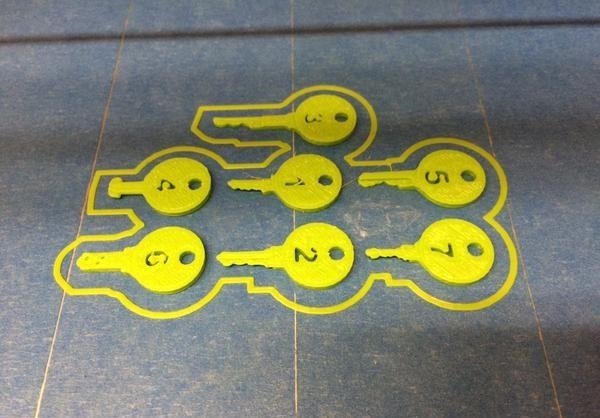How to Pick Any TSA-Approved Lock with the TSA's Leaked Master Keys
Last year, the Washington Post's Ashley Halsey wrote an article on what really happens to your luggage at airports. In it, they unwittingly published a photo of the master keys the TSA uses for TSA-approved baggage locks. Now, thanks to that picture and a French lock-picking enthusiast, anyone with a 3D printer can make their own master keys to unlock any TSA-recognized locks.

Blurred image of the master keys. Original here.Image via HeraldNet (via Washington Post)
Xylitol, the lock picker who created the CAD files, hadn't personally tried any of them out himself, but shortly thereafter, people were reporting that their printed master keys actually worked. That means, anyone that can print these keys can unlock any brand "Travel Sentry" lock, no matter if it's from Master Lock, Brinks, Samsonite, American Tourister, Stanley, or any other manufacturer.

The 3D-printing process making all the keys.Image by Xylitol/GitHub
While this is a huge security blunder by the TSA and Washington Post, approved travel locks were never truly meant to stop people from breaking into your luggage. The shackles are so thin a Leatherman could probably cut through them, they're easily picked, and you can bypass them altogether if you have a pen. The locks are primarily to help the TSA inspect suspicious luggage before it makes it onto an airplane, and have long-since been warned of their vulnerabilities.

A set of 3D-printed master keys for TSA-accepted locks.Image by Jimy Longs/Twitter
While there may be a new standard coming in the next couple years for TSA-accepted locks, you can still try this out at home on your own locks if you have a 3D printer. You can even use an online 3D printing service to do the dirty work for you, which I'll demonstrate below. (You could even trycarving them out of dinner knives if you've got the skills.)
Downloading the CAD Files
Xylitol shared all of the STL files for the TSA master keys over on GitHub, and you can download them all in this .zip file.
3D Printing Them from Your CAD Software
If you plan on printing these out at home or work, then just open up the files individually in your CAD software and print them out. In this example, I'm using Microsoft's free 3D Builder on Windows.
After opening up one of the key files, simply hit the Print button.

If you have a 3D printer connected, make sure to select that and begin printing. If not, you can order the key online from Cubify.

If you want to buy them online and have them shipped to you, hit the Continue button to begin uploading the file to Cubify.

In your web browser, Cubify should open up with pricing details. As you can see below, I was given 3 materials to choose from (I'd suggest Acutough so that the keys don't break in the locks), and they're pretty cheap at under 4 dollars. (There is a $5.00 shipping fee for each key, though, so it can get pretty pricey if you want all of them.)

You Don't Need Any CAD Software Either
If you don't have any CAD programs, and don't care to download any, you can simply upload the STL files directly to 3D printing service of your choice. Cubify is an obvious option, and the prices are the same as above with a few more material choices like Cubify Frost and Cubify Clear (which are slightly more expensive).
I also tested Shapeways and it works just as well. When you're uploading the files, just make sure to select "mm" for the units.

For the first key, I was given 17 different acceptable materials for the size and dimensions of the key, the cheapest being $2.38 from Elasto Plastic and most expensive one being $1,427,73 from Platinum. Suffice to say, the three-buck one should be good enough. Unlike with Cubify, shipping is much cheaper, as they group the products together (when possible) in one $4.99 First-Class shipment.

Most everyone is reporting that these models work well, but if you have any issues reproducing the master keys, let us know below.
0 nhận xét:
Đăng nhận xét